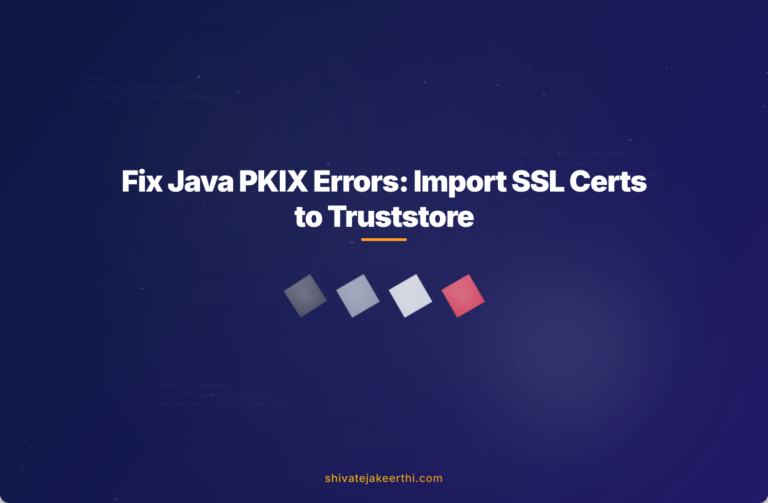If you’ve worked with Java to fetch exchange rates from sources like the European Central Bank (ECB), you’ve likely run into the frustrating PKIX path building failed error at some point. This issue often catches developers off-guard, especially after a long stable period of smooth functionality.
In simple terms, the PKIX path building failed error indicates that your Java application isn’t able to recognize or trust the provided SSL certificate when connecting to the ECB’s API. Maybe it worked fine yesterday, but suddenly, today, it’s a problem. What changed and how can you fix this? Let’s break it down.
Understanding the Problem: What Caused the PKIX Path Building Issue?
For years, fetching currency exchange rates from the ECB using Java was straightforward. Developers simply made a secure HTTP connection and read XML or other data formats. Java applications routinely connected smoothly, trusting the provided certificate from the ECB.
But recently, ECB made changes to their security protocols or updated their SSL certificates. Suddenly, your Java application throws javax.net.ssl.SSLHandshakeException, complaining about failing to establish a trusted connection.
What’s Behind the PKIX Path Building Error?
The PKIX path building failed error typically means your Java runtime does not recognize the ECB’s SSL certificate as valid. It involves the two key exceptions many developers encounter:
- javax.net.ssl.SSLHandshakeException – Indicates Java failed during SSL handshake.
- sun.security.provider.certpath.SunCertPathBuilderException – Indicates Java cannot find a valid certificate path.
Simply put, these exceptions mean Java is struggling to trust the ECB server’s certificate because it doesn’t recognize the issuer from its trusted Certificate Authorities (CA) in the JVM truststore.
Think of it as Java meeting a new face at the party that wasn’t on the guest’s list. Java is cautious—until formally introduced, it won’t trust that certificate.
Practical Steps to Quickly Fix PKIX Path Building in Java
The solution boils down to making Java recognize and trust these new or updated ECB certificates. You can fix this issue by importing the correct certificate into Java’s truststore (Java keystore).
Here’s how you tackle it:
- First, obtain the certificate from ECB’s website or directly from the API URL (using a browser).
- Import the certificate into your JVM keystore using the keytool provided by Java.
You can automate this via a Java program or manually. Let’s see the manual approach clearly first:
Open your browser (Chrome or Firefox), navigate to the ECB API URL. Click the padlock icon next to the URL bar, find the certificate details, and export it to your local machine in either .cer or .crt format.
Next, import the certificate into Java’s keystore by running the following from your command line (replace with actual file/path):
keytool -import -alias ecbcertificate -file ECB_certificatefile.cer -keystore "%JAVA_HOME%/jre/lib/security/cacerts"When prompted, the default keystore password is typically changeit. Confirm trust when asked, and you’re set!
Automatically Downloading Certificate in Java (Programmatically)
Sometimes automating certificate handling saves time and is more efficient. Consider embedding this snippet in Java to pull certificates dynamically:
import javax.net.ssl.*;
import java.io.IOException;
import java.net.URL;
import java.security.cert.Certificate;
public class CertificateDownloader {
public static void main(String[] args) throws IOException {
String urlString = "https://www.ecb.europa.eu/stats/eurofxref/eurofxref-daily.xml";
URL url = new URL(urlString);
HttpsURLConnection conn = (HttpsURLConnection) url.openConnection();
conn.connect();
Certificate[] certs = conn.getServerCertificates();
for (Certificate cert : certs) {
System.out.println(cert.toString());
}
conn.disconnect();
}
}
This snippet connects to the ECB URL, fetches certificates, and then prints information. You can export and manually add it to your truststore.
Why Do Certificates Matter Anyway?
Certificates, SSL, HTTPS—these security components are necessary precautions to protect sensitive data as it travels across the internet. Java checks certificates strictly, blocking potentially harmful or unauthorized data transfers.
If you’re new or curious about certificates, take a moment to review resources like:
- Wikipedia: Public key certificates
- Oracle Java Certificates Guide
- Stack Overflow SSL certificate threads
By thoroughly understanding certificates, you’ll confidently handle SSL-handshake errors whenever they show up in your projects.
Stack Overflow’s Recommended PKIX Solution: What’s Right & What’s Challenging
On sites like Stack Overflow, you’ll find highly rated solutions recommending exactly the approach mentioned above. Often they’ll provide step-by-step instructions involving keytool or Java code snippets.
Yet, implementing these solutions for the first time can involve challenges:
- Finding your JVM installation directory
- Using or managing multiple JDK environments
- Understanding permissions or keystore access (especially with cloud setups)
Still, investing a little time into understanding these challenges profoundly helps your Java security skillset.
A Simple Java Code Example to Read URL and Print Response
Let’s connect to ECB API now that we’ve resolved our certificate trust issues. Here’s a tested and straightforward Java snippet for reading from the HTTPS URL:
import java.io.BufferedReader;
import java.io.InputStreamReader;
import java.net.URL;
import javax.net.ssl.HttpsURLConnection;
public class ReadECBExchangeRates {
public static void main(String[] args) {
try {
URL url = new URL("https://www.ecb.europa.eu/stats/eurofxref/eurofxref-daily.xml");
HttpsURLConnection conn = (HttpsURLConnection) url.openConnection();
BufferedReader br = new BufferedReader(new InputStreamReader(conn.getInputStream()));
String inputLine;
StringBuilder response = new StringBuilder();
while((inputLine = br.readLine()) != null) {
response.append(inputLine);
}
br.close();
System.out.println(response.toString());
} catch (Exception e) {
e.printStackTrace();
}
}
}
This Java example is reliable and straightforward: it simply reads from a secure HTTPS URL (now that certificates have been correctly set) and prints the XML response containing current exchange rates.
With certificate issues resolved, connecting to secure sources becomes seamless and reliable!
Throughout your Java learning journey, certificate handling isn’t optional; it’s indispensable. Whether you’re fetching data from APIs or ensuring your own application’s secure connection, mastering certificates is crucial.
Ensure that you’re always aware when a previously trustworthy source updates or changes their certificate. Keep your JVM updated and periodically check for new certificates if errors reoccur down the road.
If you found this helpful, here’s a gentle nudge: Have you encountered PKIX path errors in other scenarios? Share your experiences or challenges below, helping all of us grow together.



0 Comments